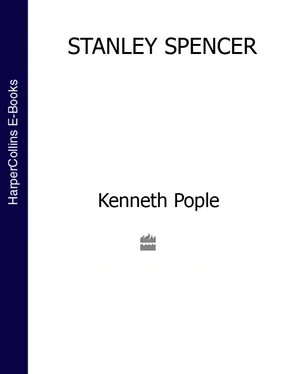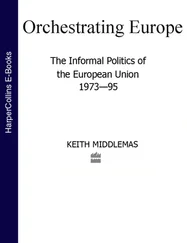In this sense it seems cogent to argue that there was in Stanley’s make-up a quality which makes him a dramatic painter. His visionary paintings capture an instant of tension between a before situation and an after situation, like a strip of movie film stopped in the projector. Each painting is that crucial freeze-frame which exactly pinpoints the moment when we become aware that a change is about to happen – The Nativity – or is happening – Apple Gatherers – or has happened – The Centurion’s Servant. The freeze-frame is not a random moment. It is the consequence of decision, more particularly of commitment. Its effect is a catharsis, a purging, the moment in drama when the confusion of reality is suddenly dissolved into spiritual comprehension. At that moment, the preceding is clarified and linked to the now inevitable. The past cannot be undone, but it can be apprehended in some awesome synthesis of meaning. A god has come.
Redemption to Stanley was the miraculous means by which he got himself, through his pictures, to where all was ‘holy, personal and at peace’; in other words, to his feelings for ‘home’. His pictures are not illustrations of redemptions. They are in themselves a reaching to redemption. It is irrelevant that the past in The Centurion’s Servant may be a recollection of some serious Spencer family illness or that Stanley has portrayed the future as an expression of ‘cosiness’ in bed, its valance echoing those of Edwardian prams. Neither the title, nor its allusions, nor its associations are to be taken at face value, and to do so is to limit, even destroy, their meaning. Particularly with this picture Stanley felt that critics might decide its presentation derived from an unpatriotic reluctance to go to the war. The thought of such possibility could never be allowed to interfere with the form of the work. If the content came to him vividly, then it must be valid, demanding expression without dissemblance. Only so could a path be cleared through confusion to meaning. The best precaution he could presently take against misinterpretation was to conceal the painting, even though the clarity he found in its execution convinced him of the truth of his feelings:
My bed picture is an example of how a picture ought to be painted. Everything in that picture, colour particularly, was perfectly clear, and the way to get the colour decided in my mind before I put brush to canvas. The result was that it was done in no time, it was done like clockwork. … What pleases me is that I have learned the reason why the picture should be done so as to let me see the idea without having to plough through incompetent [irrelevant] detail that has no fundamental bearing on the idea. 9 *
Stanley’s excitement at his achievement is obvious. Some outside force is acting on him, easing his mental suffering into that state of peace through which he can joyfully offer tribute. His picture ‘lets him see’ his idea in uncluttered clarity. The joy it gave him sprang not from the fact that the picture indicated a solution to the perplexity from which it originated; the imperative of physical reality continued to assail. Rather his joy sprang from a discovery that the making of the picture discharged his emotional distress. It was a redemption. In it, reason became the servant of imagination, imagination of feeling, feeling of revelation, revelation of comprehension, and comprehension the miraculous gift from some exterior power. The process was religious. When in later years an art critic interpreted it as the reaction of children caught in an air-raid, Stanley’s contempt was vitriolic *
For the time being, however, nothing was done with the painting. Stanley stored it in his room at Fernlea while he settled to other work. One such was among the first of what must be called his ‘landscapes’: the painting of Cookham, 1914.
CHAPTER EIGHT
Cookham, 1914
Excuse my muddle-headedness and slowness, when I see anything I see everything, and when I can’t see one thing I see absolutely nothing.
Stanley Spencer 1
SUPERFICIALLY The Nativity and even John Donne Arriving in Heaven can be classified as landscapes. But Stanley would not have regarded them so. For him landscapes, like still-lifes and portraits, captured tangible objects in real time. They can be called his observed paintings. Unlike his visionary or compositional work, observed paintings were invariably painted or sketched in situ , where possible in contiguous sessions. In them detail is precise and often continued full into the foreground, a technique which gives such paintings wide-angle clarity of definition and the strong visual impact resulting from great depth of field. *An ancillary of the method, the use of a high-angle viewpoint, occurs in his first major landscape, Cookham, 1914 , and has been proposed as imaginary, 3because Stanley often used such viewpoints in subsequent visionary work. But he never did so, we can be sure, in observed paintings. There will exist an exact spot near Cookham which shows the scene precisely as Stanley saw it. It has been identified as near Terry’s Lane in Cookham leading up to Winter Hill, a little beyond Rowborough House. 4
In the most compelling of Stanley’s landscapes, we glimpse the power that place had for him: ‘My landscape painting has enabled me to keep my bearings. It has been my contact with the world, my soundings taken, my plumb-line dropped.’ 5Meticulousness of detail was not an arbitrarily adopted style. He could paint in no other way, for the precision in his personality was the physical manifestation of his inner search for veracity. Cookham, 1914 was the forerunner of a magnificent procession of observed paintings, hundreds in all, so decorative and so sought-after that he found himself frequently leaning on them for income. At times he complained of having to churn them out. Sometimes his complaint was justified because he was too rushed and the result mechanical. But in less hurried times he could enjoy the contemplative opportunities they afforded. We should not be deceived by his wail; it reflects only annoyance that he had to give them precedence at periods when he wanted to concentrate on visionary work.
Place, for Stanley, meant objects observed in relation to one another. In a newly observed scene neither the objects nor their relationship would have an immediate impact. Only when he drew some associative inference would the place take meaning. The process needed time. Given time, the place would assume for him an identity from his perception of its components. Change one, and for him the entire identity of the place changed. Thus his more powerful landscapes became connections between himself and the spirit of the landscape which had imposed its identity on him. At the moment of imposition, of connection, the place became an entity, a stasis.
Thus his landscapes in general lack figures. An animate figure, however discreet, would be an intrusion in the stasis of the scene. But stasis does not imply passivity. Each landscape in which place sang for Stanley revealed to him a necessary natural creation which would persist whether or not man interferes. He told Edward Marsh, who bought Cookham, 1914 , 6‘I think the true landscape you have of mine has a feeling of leading to something I want in it, I know I was reading English Ballads at the time and feeling a new and personal value of the Englishness of England.’ 7It is in the brooding calm of their existence that the power for Stanley of such landscapes rests. They are simply being.
When then is the distinction between such paintings and his visionary work? Why were the latter more significant for him? Essentially it was a question of how fully he could join himself to whatever he was painting. In observed painting, even the most sympathetic, he was not able wholly to amalgamate himself with his subject: ‘It is strange that I feel so “lonely” when I draw from nature, but it is because no sort of spiritual activity comes into the business at all – it’s this identity business,’ he was later to write. 8Place became ecstatic for him when it became wholly subjective: ‘It must be remembered that whatsoever I talk about is the whole thing, by which I mean that if I refer to a place, I am talking of a place plus myself plus all associating matters of personal characteristics respecting myself.’ 9He saw it through a filter of personal associations which transfigured it into metaphysical meaning.
Читать дальше









![Brian Thompson - A Monkey Among Crocodiles - The Life, Loves and Lawsuits of Mrs Georgina Weldon – a disastrous Victorian [Text only]](/books/704922/brian-thompson-a-monkey-among-crocodiles-the-life-thumb.webp)


